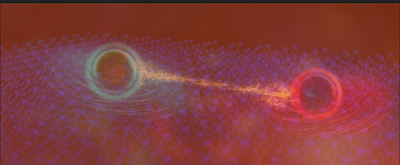The new type of hybrid particles can be used along with the graphene layers.
When
we are thinking about the possibility to use graphene in quantum
computers, we can think that the atoms of some other particles are
pointed in the middle of the carbon ring. Then the electromagnetic
stress will target that atom, which is superpositioning or transmitting
its electromagnetic field to the graphene structure. And that thing
would make it possible to create new and more powerful quantum computers
that might be even more fundamental than ever before.
One of
the areas, where large graphene layers can use is quantum computing. The
qubits can fly freely between the graphene layers, whose mission is to
protect them against outer radiation. The image above this text
portraits the new quantum material, but it could also portray the
superpositioned particles.
Using the superposition the particles
can transmit data from one place to another, and the quantum
entanglement will deny that nobody sees the data, what travels in the
energy bridge between those particles. The thing is that by benefiting
graphene the particle can anchor to the layer, and then the energy or
the electromagnetic radiation can be targeted to that particle.
That
thing would rise the energy layer of that particle, and the
electromagnetic field can multiposition to other particles around that
single particle, which can hover between the graphene layer and electric
antenna. The system might base a similar idea with the scanning
tunneling microscope. The ion or electron would hover between the layer
and antenna, and the electromagnetic stress will target that hovering
atom. If there are other particles at a certain distance from that
primary particles, its electromagnetic field can transmit to those
particles.
https://www.sciencealert.com/an-unexpected-observation-in-insulators-hints-at-a-new-kind-of-hybrid-particle
Image: https://www.sciencealert.com/an-unexpected-observation-in-insulators-hints-at-a-new-kind-of-hybrid-particle
 |
Graphene is the material of tomorrow
The one atom layer graphite
or graphene is theoretically very easy to make. The thing that is
enough is that the entire layer is covered by using graphite, and then
the extra-layers will be removed. The idea is simple. The whole area is
colored with a pencil, and then the extra-atomic layers of graphite are
removed by using lasers.
So if there is the possibility that the
large areas are covered by using graphene, that thing would allow
making the extremely hard layer over the metal, but there are many other
targets, where graphene can use. Now the scientists are introducing the
idea that graphene can be produced from plastic garbage. And that thing
opens the new visions for using graphene in the many targets.
https://massivesci.com/articles/plastic-recycling-graphene-flash-joule-heating/
Image: https://en.wikipedia.org/wiki/Graphene




No comments:
Post a Comment
Note: Only a member of this blog may post a comment.